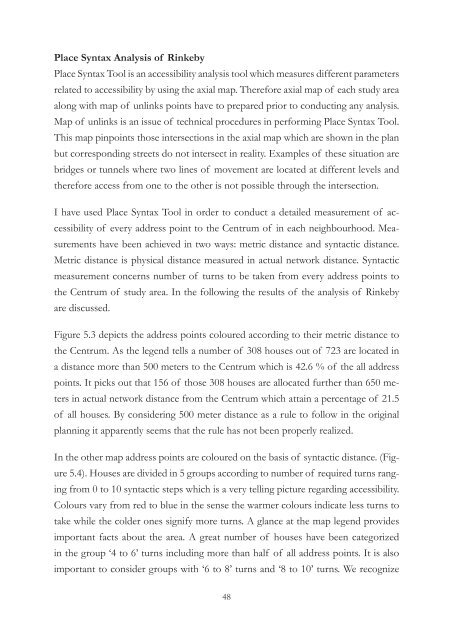Accessibility and Street Layout Exploring spatial equity in
Accessibility and Street Layout Exploring spatial equity in
Accessibility and Street Layout Exploring spatial equity in
You also want an ePaper? Increase the reach of your titles
YUMPU automatically turns print PDFs into web optimized ePapers that Google loves.
Place Syntax Analysis of R<strong>in</strong>keby<br />
Place Syntax Tool is an accessibility analysis tool which measures different parameters<br />
related to accessibility by us<strong>in</strong>g the axial map. Therefore axial map of each study area<br />
along with map of unl<strong>in</strong>ks po<strong>in</strong>ts have to prepared prior to conduct<strong>in</strong>g any analysis.<br />
Map of unl<strong>in</strong>ks is an issue of technical procedures <strong>in</strong> perform<strong>in</strong>g Place Syntax Tool.<br />
This map p<strong>in</strong>po<strong>in</strong>ts those <strong>in</strong>tersections <strong>in</strong> the axial map which are shown <strong>in</strong> the plan<br />
but correspond<strong>in</strong>g streets do not <strong>in</strong>tersect <strong>in</strong> reality. Examples of these situation are<br />
bridges or tunnels where two l<strong>in</strong>es of movement are located at different levels <strong>and</strong><br />
therefore access from one to the other is not possible through the <strong>in</strong>tersection.<br />
I have used Place Syntax Tool <strong>in</strong> order to conduct a detailed measurement of accessibility<br />
of every address po<strong>in</strong>t to the Centrum of <strong>in</strong> each neighbourhood. Measurements<br />
have been achieved <strong>in</strong> two ways: metric distance <strong>and</strong> syntactic distance.<br />
Metric distance is physical distance measured <strong>in</strong> actual network distance. Syntactic<br />
measurement concerns number of turns to be taken from every address po<strong>in</strong>ts to<br />
the Centrum of study area. In the follow<strong>in</strong>g the results of the analysis of R<strong>in</strong>keby<br />
are discussed.<br />
Figure 5.3 depicts the address po<strong>in</strong>ts coloured accord<strong>in</strong>g to their metric distance to<br />
the Centrum. As the legend tells a number of 308 houses out of 723 are located <strong>in</strong><br />
a distance more than 500 meters to the Centrum which is 42.6 % of the all address<br />
po<strong>in</strong>ts. It picks out that 156 of those 308 houses are allocated further than 650 meters<br />
<strong>in</strong> actual network distance from the Centrum which atta<strong>in</strong> a percentage of 21.5<br />
of all houses. By consider<strong>in</strong>g 500 meter distance as a rule to follow <strong>in</strong> the orig<strong>in</strong>al<br />
plann<strong>in</strong>g it apparently seems that the rule has not been properly realized.<br />
In the other map address po<strong>in</strong>ts are coloured on the basis of syntactic distance. (Figure<br />
5.4). Houses are divided <strong>in</strong> 5 groups accord<strong>in</strong>g to number of required turns rang<strong>in</strong>g<br />
from 0 to 10 syntactic steps which is a very tell<strong>in</strong>g picture regard<strong>in</strong>g accessibility.<br />
Colours vary from red to blue <strong>in</strong> the sense the warmer colours <strong>in</strong>dicate less turns to<br />
take while the colder ones signify more turns. A glance at the map legend provides<br />
important facts about the area. A great number of houses have been categorized<br />
<strong>in</strong> the group ‘4 to 6’ turns <strong>in</strong>clud<strong>in</strong>g more than half of all address po<strong>in</strong>ts. It is also<br />
important to consider groups with ‘6 to 8’ turns <strong>and</strong> ‘8 to 10’ turns. We recognize<br />
48

















